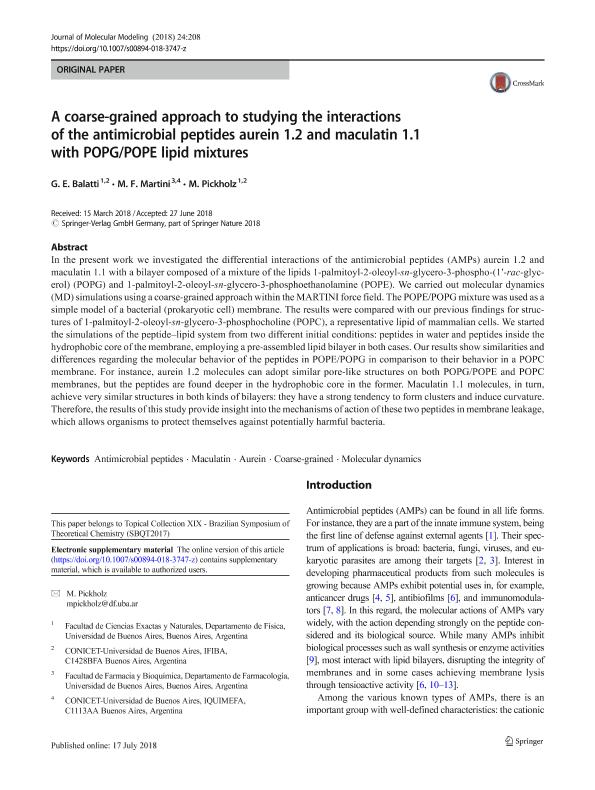Artículo
A coarse-grained approach to studying the interactions of the antimicrobial peptides aurein 1.2 and maculatin 1.1 with POPG/POPE lipid mixtures
Fecha de publicación:
08/2018
Editorial:
Springer
Revista:
Journal of Molecular Modeling
ISSN:
1610-2940
Idioma:
Inglés
Tipo de recurso:
Artículo publicado
Clasificación temática:
Resumen
In the present work we investigated the differential interactions of the antimicrobial peptides (AMPs) aurein 1.2 and maculatin 1.1 with a bilayer composed of a mixture of the lipids 1-palmitoyl-2-oleoyl-sn-glycero-3-phospho-(1′-rac-glycerol) (POPG) and 1-palmitoyl-2-oleoyl-sn-glycero-3-phosphoethanolamine (POPE). We carried out molecular dynamics (MD) simulations using a coarse-grained approach within the MARTINI force field. The POPE/POPG mixture was used as a simple model of a bacterial (prokaryotic cell) membrane. The results were compared with our previous findings for structures of 1-palmitoyl-2-oleoyl-sn-glycero-3-phosphocholine (POPC), a representative lipid of mammalian cells. We started the simulations of the peptide–lipid system from two different initial conditions: peptides in water and peptides inside the hydrophobic core of the membrane, employing a pre-assembled lipid bilayer in both cases. Our results show similarities and differences regarding the molecular behavior of the peptides in POPE/POPG in comparison to their behavior in a POPC membrane. For instance, aurein 1.2 molecules can adopt similar pore-like structures on both POPG/POPE and POPC membranes, but the peptides are found deeper in the hydrophobic core in the former. Maculatin 1.1 molecules, in turn, achieve very similar structures in both kinds of bilayers: they have a strong tendency to form clusters and induce curvature. Therefore, the results of this study provide insight into the mechanisms of action of these two peptides in membrane leakage, which allows organisms to protect themselves against potentially harmful bacteria.
Palabras clave:
ANTIMICROBIAL PEPTIDES
,
AUREIN
,
COARSE-GRAINED
,
MACULATIN
,
MOLECULAR DYNAMICS
Archivos asociados
Licencia
Identificadores
Colecciones
Articulos(IFIBA)
Articulos de INST.DE FISICA DE BUENOS AIRES
Articulos de INST.DE FISICA DE BUENOS AIRES
Articulos(IQUIMEFA)
Articulos de INST.QUIMICA Y METABOLISMO DEL FARMACO (I)
Articulos de INST.QUIMICA Y METABOLISMO DEL FARMACO (I)
Citación
Balatti, Galo Ezequiel; Martini, María Florencia; Pickholz, Mónica Andrea; A coarse-grained approach to studying the interactions of the antimicrobial peptides aurein 1.2 and maculatin 1.1 with POPG/POPE lipid mixtures; Springer; Journal of Molecular Modeling; 24; 8; 8-2018
Compartir
Altmétricas




